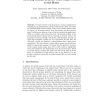Free Online Productivity Tools
i2Speak
i2Symbol
i2OCR
iTex2Img
iWeb2Print
iWeb2Shot
i2Type
iPdf2Split
iPdf2Merge
i2Bopomofo
i2Arabic
i2Style
i2Image
i2PDF
iLatex2Rtf
Sci2ools
PERVASIVE
2006
Springer
2006
Springer
Modeling Human Behavior from Simple Sensors in the Home
Pervasive sensors in the home have a variety of applications including energy minimization, activity monitoring for elders, and tutors for household tasks such as cooking. Many of the common sensors today are binary, e.g. IR motion sensors, door close sensors, and floor pressure pads. Predicting user behavior is one of the key enablers for applications. While we consider smart home data here, the general problem is one of predicting discrete human actions. Drawing on Activity Theory, the Language-as-Action principle, and Speech understanding research, we argue that smoothed n-grams are very appropriate for this task. We built such a model and applied it to data gathered from 3 smart home installations. The data showed a classic Zipf or power-law distribution, similar to speech and language. We found that the predictive accuracy of the n-gram model ranges from 51% to 39%, which is significantly above the baseline for the deployments of 16, 76 and 70 sensors. While we cannot directly com...
Related Content
| Added | 14 Dec 2010 |
| Updated | 14 Dec 2010 |
| Type | Journal |
| Year | 2006 |
| Where | PERVASIVE |
| Authors | Ryan Aipperspach, Elliot Cohen, John F. Canny |
Comments (0)

